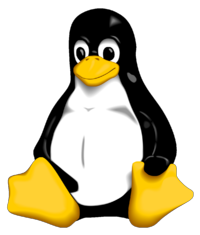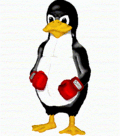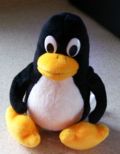Tux/Citable Version
Tux the penguin is the official logo, and cartoon mascot, for the Linux computer operating system. First drawn in 1996 by Larry Ewing, the fun-loving character has a special place in people's imaginations both inside and outside of the global Linux community.
Quest for a Linux logo
Tux originated from a discussion on the Usenet "Linux kernel" mailing list. On May 1, 1996, Matt Hartley began a thread titled "Linux logo", which included an image by David Christiansen showing the planet Earth as seen from outer space, along with the captions "LINUX" and "Take your computer to another dimension."[1][2] The next day Alan Cox posted a message suggesting that the Linux logo should be "a picture of the BSD daemon"—the logo for another open source operating system—"flat out on the floor with stars around its head and a penguin in boxing gloves standing on top."[3] Disagreeing, Mark Lehrer countered that FreeBSD was not Linux's real competition. Microsoft's Windows 95 was—then the dominant operating system worldwide—so the logo should instead show the BSD Daemon smashing a window.[4] Alan Clucas countered back that these two ideas would be best if combined, with a fighting BSD Daemon victorious over both its operating system competitors.[5]
Tux takes shape and is named
Yet Linus Torvalds, the software engineer behind Linux, could not endorse the official mocking of other operating systems; so, he countered with his own idea. Someone artistic should base a logo on his favorite image of a penguin and release it under a free license.[6] Torvalds emphatically stated that his penguin concept was final.
Not long after, Dale Scheetz posted a prototype of a penguin holding up the Earth, combining Christiansen's original idea with Torvalds's.[7] Torvalds was doubtful, however, saying the penguin looked too weak to hoist an entire planet—the bird appeared in imminent danger of being squashed, in fact! The penguin logo, Torvalds thought, should instead be cute and cuddly. He envisioned the bird sitting, content and smiling, having just let out a small burp after a grand feast of herring. And the bird was not to be fat, just happily gorged with fish.[8]
It was Larry Ewing who then drew the original version of the Linux penguin—on a computer running Linux, of course.[9] Once completed, the new mascot needed a name. Humorously, one of the earliest suggestions, from Henning Schmiedehausen, was "Homer", because to him the bird resembled Homer Simpson the television character.[10] [11] Some then suggested "Linnie" for the penguin's name, but it was "Tux", coined by James Hughes, that soon caught on. This name had a two-fold meaning: as an acronym for Torvalds Unix, and as a pun based on the shortening of tuxedo, which penguins are often said to be wearing.[12] [13]
Continued "distributions" of Tux
Tux was therefore born of what Torvalds had often expressed as his affinity for penguins. He once joked he had caught "penguinitis" after being bitten by a ferocious one, saying his "disease" caused him to "stay awake at nights just thinking about penguins and feeling great love towards them".[14] Some years later, Torvalds confessed he never was really looking for a "Linux Corporate Image" through the idea, but for something fun that could be extensively modified yet still be recognizable.
It's not surprising, then, that Tux has never been static—like Linux itself. From the beginning, people have felt free "play with" and re-draw the character in a variety of "goofy" ways. They have creatively cast Tux in a variety of ways, including as a skateboarder, a ninja, and a pipe-smoker. They have given Tux appearances in magazines, television broadcasts, video games and other software, and mouse-pads, and on clothing, stickers, and other paraphernalia. Sculptor Eric Harshbarger made a 25" Lego model of Tux,[15] and anyone can make a plush toy out of him (see photo at right) from freely available cut-out patterns.[16]
Most recently, some have suspected Tux to have competing romantic involvements. Gown and Penny, two female penguins, have appeared in several open source games. Tux's status remains unclear, however, since the gals are not official Linux projects.
References
- ↑ Matt Hartley (1996-05-5). Linux logo.
- ↑ David Christiansen. lin64.jpg.
- ↑ Alan Cox (1996-05-2). Re: Linux logo (LKML).
- ↑ Mark Lehrer (1996-05-4). Re: Linux logo.
- ↑ Alan Clucas (1996-05-4). Re: Linux logo.
- ↑ See ftp://ftp.cs.helsinki.fi/pub/Software/Linux/Kernel/v1.3/ccpenguin.jpg for the original image posted by Torvalds.
- ↑ Dale Scheetz (1996-05-9). Linux Logo prototype..
- ↑ Linus Torvalds (1996-05-9). Re: Linux Logo prototype..
- ↑ A complete description of the methods Ewing used is on his website, http://www.isc.tamu.edu/~lewing/linux/notes.html.
- ↑ Henning Schmiedehausen (1996-06-10). Re: Let's name the penguin! (citation 1).
- ↑ As a joke, Anton Johansson responded to Schmiedehausen's suggestion by morphing an image of Homer Simpson into a penguin.
- ↑ James Hughes (1996-06-10). Re: Let's name the penguin! (citation 2).
- ↑ LD Landis (1996-06-12). Re: Let's name the penguin! (citation 3).
- ↑ Steve Baker. A Complete History of Tux.
- ↑ Eric Harshbarger. Linux Penguin - LEGO.
- ↑ See http://www.free-penguin.org
Other software mascots
- The BSD Daemon, the mascot of the various Berkeley Software Distribution releases
- Wilber, the mascot of The GIMP
Subtopics
External links
- ccpenguin.jpg Torvalds' original penguin image. At his recommendation, Tux is based on this image


